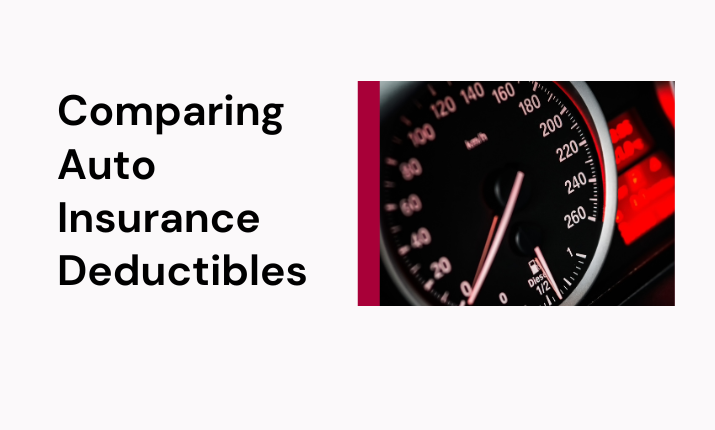Introduction
Selecting the ideal auto insurance deductible can dramatically affect premiums and financial security in case of an accident. This article will guide you through comparing auto insurance deductibles, helping you make a well-informed decision suited to your needs and budget.
Understanding Auto Insurance Deductibles
An auto insurance deductible is the amount you agree to pay out-of-pocket before your policy kicks in to cover the remaining costs from an accident claim.
Fixed Dollar Amount Deductibles.
These deductibles are set at a specific dollar amount, such as $500 or $1000.
Percentage-Based Deductibles
These deductibles are calculated as a percentage of the total claim amount. When choosing a deductible, factor in budget considerations and affordability.
Assess how much of an out-of-pocket payment you are comfortable making in case of a claim.
Premium Costs
Understand the inverse relationship between deductibles and premiums – higher deductibles often translate to reduced premiums. Risk Tolerance Driving History
Consider Your Driving Record
a lower deductible might be more suitable if you have an accident history. Frequency of Claims: monitors how frequently you have filed claims in the past – if filing claims often, it may warrant increasing it a bit further.
Vehicle Value
For newer, more expensive vehicles, a higher deductible might be wise. When considering depreciation factors affecting vehicle value, such as rate of depreciation. Deductibles Have an Effect on Premiums High
Deductibles Can Lead to Lower Premiums
Higher deductibles usually mean lower monthly or annual premiums, though you will become responsible for more in the event of a claim.
Lower Deductibles Mean Higher Premium Costs
With lower deductibles come lower out-of-pocket costs in case of an incident.
Before Making Your Decision, Consider your circumstances carefully when deciding between deductible options, considering their pros and cons as you search for one that satisfies both affordability and financial security.
Now that you understand the significance of auto insurance deductibles, here are some helpful strategies for effectively managing them:
Establish an Emergency Fund
Creating an emergency fund, including saving for insurance deductibles, is one way to gain peace of mind and financial security.
Examine Your Driving Habits
Choosing a higher deductible could be the smartest financial move if your driving record is impeccable and your mileage low.
Review Your Policy Annually
Your circumstances change over time, and so too may your insurance needs. Make sure to review your policy each year to make sure it still fits with your current situation.
Bundle Policies
Bundling multiple policies together may result in significant savings and can help offset potential deductible costs.
Assess Comprehensive Coverage
Review the comprehensive coverage aspect of your policy. Adjusting the deductible specifically for this coverage in certain instances may make sense.
Claim Process and Deductibles
Being informed about how the claims process typically works can make life much simpler in the unfortunate event of an accident, so here is how it naturally unfolds about your deductible:
File a Claim:
Initiate the claims process by contacting your insurance provider.
An adjuster will assess and repair any damages to your car, while any necessary maintenance repairs will also be coordinated.
Deductible Payment:
Your deductible payment should be made directly to the repair shop.
Once Your Deductible Has Been Paid:
Once your deductible has been met, your insurance coverage will cover any outstanding costs.
Auto Insurance Deductibles in Risk Management
Deductibles play a key role in risk management. While they may negatively affect your finances in the short term, they are invaluable protection against large financial losses in case of an accident.
Conclusion
Selecting an auto insurance deductible that best meets your financial needs can have far-reaching ramifications, so considering factors such as budget, risk tolerance, and vehicle value will allow for informed choices that suit your unique situation. Remember, there’s no universal solution, so carefully evaluate each special circumstance before selecting.
Frequently Asked Questions
What are the typical auto insurance deductibles?
Some policies may offer higher deductible options for auto insurance; deductibles typically fall between $250 and $1500.
Can I change my deductible after purchasing my policy?
When renewing your policy, you can typically adjust your deductible amount.
Will a higher deductible cost more when making claims?
Yes, selecting a higher deductible means you will be responsible for an upfront payment if filing a claim.
Will my vehicle’s age affect my selection of a deductible?
Newer vehicles might warrant a lower deductible to protect their investment; older ones with lower values might necessitate higher ones.
Are there exceptions where this deductible doesn’t apply?
Yes, in certain circumstances (for instance, if there was an unknowing hit-and-run collision), deductible payments may not apply.

